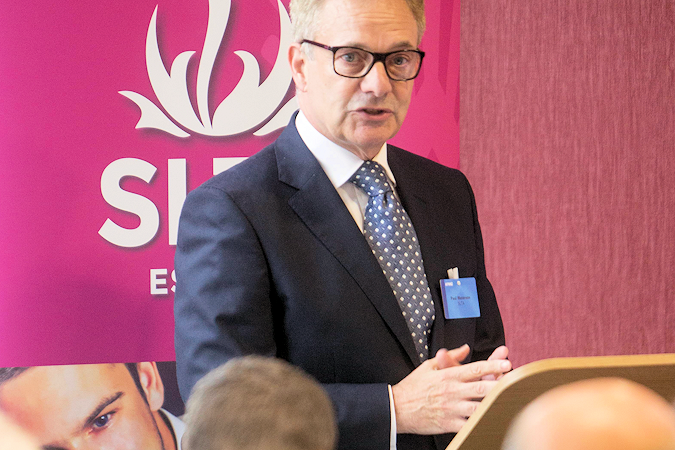BROAD-RANGING measures implemented to change the way the SLTA engages with its members and the industry are proving effective and have been well received. That was the message from chief executive Paul Waterson when he spoke at the trade organisation’s Chairman’s Lunch in Glasgow earlier this month.
Updating attendees on the progress to date of the SLTA’s three-year Time for Change action plan, he paid tribute to the invaluable support of the trade organisation’s many suppliers and other service providers which had come on board as industry partners. “In developing and gaining financial support for the ‘new’ SLTA brand, the association needed to build a more professional relationship with companies rather than simply relying on their goodwill,” he said.
“I am happy to report that major progress has been made – progress that has been achieved thanks to the help of many in this room. It is also demonstrated by the growing number of supporting companies we now have.”
Thanking the companies and organisations which had joined forces with the SLTA, Waterson confirmed that “we are continuing to work hard on attracting new corporate partners”.
The SLTA’s aims for the first year of the strategy were to raise the association’s profile, attain sustainability by driving more engagement within the industry, create a more modern image, improve communication channels and become more involved in training. “We have created a more contemporary image and last year our new brand identity was unveiled to reflect a fresh approach and renewed focus on industry engagement,” he said.
“This modern, dynamic identity plays an important role in challenging existing perceptions of the SLTA and general ongoing feedback indicates it has, and continues to, capture the imagination of the Scottish on-trade.”
In terms of improving communications, Waterson pointed to the association’s website which has been completely revamped to reflect the main functions of the rejuvenated SLTA. Latest figures show a 75% year-on-year increase in traffic with visitors spending more time on the website than ever before.
“This has been helped by a responsive design that allows for a consistent experience across all browsing devices,” he said. “As part of our strengthened communications strategy we can now liaise directly with our core members, our bartenders’ network, Personal Licence Holders and partners on a regular basis through our monthly trade news email feeds. We also continue to grow our social media presence through Twitter and Facebook accounts.”
The SLTA’s external media presence is also key to the association’s high profile, Waterson continued. “It is fair to say that not much happens in the trade without us being asked to comment,” he said. “Often press enquiries can come in on an almost daily basis and we are constantly asked for the trade’s opinion on a wide variety of subjects.”
Waterson pointed to the introduction by the SLTA of regular market insight reports, which offer a “ground level, knowledgeable view from licensees at the front end of the business”. He said: “Our last four reports, sponsored by KPMG, have consisted of a review of performance across the core categories of beers, wines and spirits.
“They also look at the importance of geography, contrasting on-trade performance in city-centre locations versus tourist and remote locations, and the impact of various political factors on the business. These have been very well received by our members, our corporate partners and the media.
“Our fifth market insight report, sponsored by Gerald Eve, is published by the association to give information relating to the imminent rating revaluation. It is obvious from the results, with over 700 premises represented, that this revaluation is causing great concern to all within the on-trade in Scotland, and we will be working hard to ensure that we are all treated fairly in the revaluation process.”
Discussing SLTA membership, Waterson reiterated the association’s view that it can only continue to protect and develop the trade efficiently and effectively by bringing together all sections of the on-trade. To that end, the amalgamation with the 1000-strong Scottish Bartenders Network – giving the association access to bartenders, mixologists, beer and wine sommeliers and helping to engage with younger members of the licensed trade – is complete.
Another pivotal innovation is the registration and communication channel for all Personal Licence Holders in the Scottish on-trade. “This gives a membership path as people move through the business,” said Waterson. “Our target was to have a database of 5000 contacts by the end of year two but I am glad to report that the news feed now goes directly to just over 5000 individuals – the two-year target being achieved in only 10 months.”
The SLTA, he continued, had been reinvigorated. “Our initial short-term goals have been realised but the day-to-day work of the SLTA goes on,” said Waterson. “As always, we are involved in a diverse range of subjects – from advising our members on licensing issues to our work, through our membership of the British Pub Confederation, on tenancy issues, and from positive messages about the role of our premises in Scottish society and tourism, to concerns over the introduction of the National Living Wage.
“From our work liaising with Police Scotland on controversial operational issues to our position on the introduction of the ‘social responsibility fee’. From our response to the cross-party commission set up to examine new ways to fund local government in Scotland to new Scottish Government recycling legislation.
“From being part of substantial trade coalitions lobbying to cut hospitality VAT and the proposed sugar tax to the introduction of minimum pricing – we are involved.
“In all of these subjects, and lots more, it’s important the voice of the on-trade is heard,” Waterson concluded.

